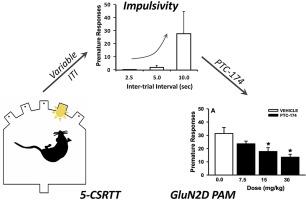当前位置:
X-MOL 学术
›
Neuropharmacology
›
论文详情
Our official English website, www.x-mol.net, welcomes your feedback! (Note: you will need to create a separate account there.)
Modulating inhibitory response control through potentiation of GluN2D subunit-containing NMDA receptors.
Neuropharmacology ( IF 4.7 ) Pub Date : 2020-02-11 , DOI: 10.1016/j.neuropharm.2020.107994 Patrick M Callahan 1 , Alvin V Terry 1 , Frederick R Nelson 2 , Robert A Volkmann 2 , A B Vinod 3 , Mohd Zainuddin 3 , Frank S Menniti 4
Neuropharmacology ( IF 4.7 ) Pub Date : 2020-02-11 , DOI: 10.1016/j.neuropharm.2020.107994 Patrick M Callahan 1 , Alvin V Terry 1 , Frederick R Nelson 2 , Robert A Volkmann 2 , A B Vinod 3 , Mohd Zainuddin 3 , Frank S Menniti 4
Affiliation

|
NMDA receptors containing GluN2D subunits are expressed in the subthalamic nucleus and external globus pallidus, key nuclei of the indirect and hyperdirect pathways of the basal ganglia. This circuitry integrates cortical input with dopaminergic signaling to select advantageous behaviors among available choices. In the experiments described here, we characterized the effects of PTC-174, a novel positive allosteric modulator (PAM) of GluN2D subunit-containing NMDA receptors, on response control regulated by this circuitry. The indirect pathway suppresses less advantageous behavioral choices, a manifestation of which is suppression of locomotor activity in rats. Systemic administration of PTC-174 produced a dose-dependent reduction in activity in rats placed in a novel open field or administered the stimulants MK-801 or amphetamine. The hyperdirect pathway controls release of decisions from the basal ganglia to the cortex to optimize choice processing. Such response control was modeled in rats as premature responding in the 5-choice serial reaction time (5-CSRT) task. PTC-174 produced a dose-dependent reduction in premature responding in this task. These data suggest that potentiation of GluN2D receptor activity by PTC-174 facilitates the complex basal ganglia information processing that underlies response control. The behavioral effects occurred at estimated free PTC-174 brain concentrations predicted to induce 10-50% increases in GluN2D activity. The present findings suggest the potential of GluN2D PAMs to modulate basal ganglia function and to treat neurological disorders related to dysfunctional response control.
中文翻译:

通过增强含有 GluN2D 亚基的 NMDA 受体来调节抑制反应控制。
含有 GluN2D 亚基的 NMDA 受体在丘脑底核和苍白球外表达,它们是基底神经节间接和超直接通路的关键核。该电路将皮层输入与多巴胺能信号集成在一起,以在可用选择中选择有利的行为。在此处描述的实验中,我们表征了 PTC-174(一种含有 GluN2D 亚基的 NMDA 受体的新型正变构调节剂 (PAM))对该电路调节的反应控制的影响。间接途径抑制不太有利的行为选择,其表现是抑制大鼠的运动活动。PTC-174 的全身给药在放置在新开放领域或给予兴奋剂 MK-801 或苯丙胺的大鼠中产生剂量依赖性的活性降低。超直接通路控制从基底神经节到皮层的决策发布,以优化选择处理。这种反应控制在大鼠中被建模为在 5 项选择系列反应时间 (5-CSRT) 任务中的过早反应。PTC-174 在此任务中产生了剂量依赖性减少过早反应。这些数据表明 PTC-174 对 GluN2D 受体活性的增强促进了作为反应控制基础的复杂基底神经节信息处理。行为影响发生在估计的游离 PTC-174 脑浓度下,预计会导致 GluN2D 活性增加 10-50%。目前的研究结果表明,GluN2D PAMs 具有调节基底神经节功能和治疗与功能失调反应控制相关的神经系统疾病的潜力。
更新日期:2020-02-11
中文翻译:

通过增强含有 GluN2D 亚基的 NMDA 受体来调节抑制反应控制。
含有 GluN2D 亚基的 NMDA 受体在丘脑底核和苍白球外表达,它们是基底神经节间接和超直接通路的关键核。该电路将皮层输入与多巴胺能信号集成在一起,以在可用选择中选择有利的行为。在此处描述的实验中,我们表征了 PTC-174(一种含有 GluN2D 亚基的 NMDA 受体的新型正变构调节剂 (PAM))对该电路调节的反应控制的影响。间接途径抑制不太有利的行为选择,其表现是抑制大鼠的运动活动。PTC-174 的全身给药在放置在新开放领域或给予兴奋剂 MK-801 或苯丙胺的大鼠中产生剂量依赖性的活性降低。超直接通路控制从基底神经节到皮层的决策发布,以优化选择处理。这种反应控制在大鼠中被建模为在 5 项选择系列反应时间 (5-CSRT) 任务中的过早反应。PTC-174 在此任务中产生了剂量依赖性减少过早反应。这些数据表明 PTC-174 对 GluN2D 受体活性的增强促进了作为反应控制基础的复杂基底神经节信息处理。行为影响发生在估计的游离 PTC-174 脑浓度下,预计会导致 GluN2D 活性增加 10-50%。目前的研究结果表明,GluN2D PAMs 具有调节基底神经节功能和治疗与功能失调反应控制相关的神经系统疾病的潜力。



























 京公网安备 11010802027423号
京公网安备 11010802027423号